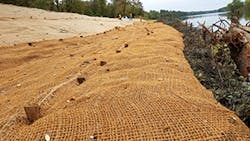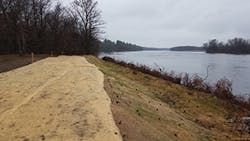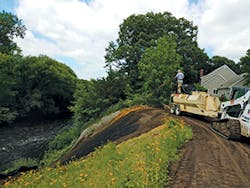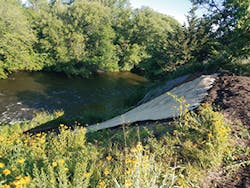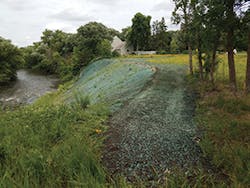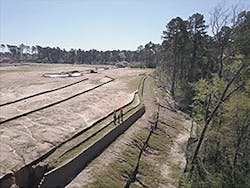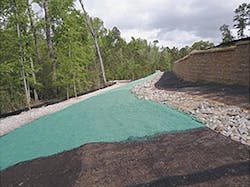Blankets and mats are rather ordinary tools of the erosion control trade. They usually don’t look pretty or fancy. At best, they are tinted green to look somewhat natural, to blend in until the seed beneath them can germinate and the real vegetation can start growing.
But what blankets and mats do is valuable and multifaceted. From a practical standpoint, they save contractors and landowners time and money. By keeping seeds, soil, and other erosion control materials in place—despite the forces of wind and rain—they make sure that a job doesn’t have to be done more than once, thus saving the costs of labor and extra materials.
Erosion control blankets and mats are heavy lifters in the world of environmental compliance. Even with the most powerful soil amendments and fertilizers, seeds take time to germinate, and plants need time to grow and spread their roots to hold soil in place. Keeping that soil from eroding away is essential for protecting the water quality of a community’s streams. It is also necessary for avoiding violations of federal and state environmental regulations.
Blankets and mats are made in a range of sizes and from various natural and synthetic materials. They are available in various types that biodegrade either quickly or slowly, or that remain in place permanently. Some mats and blankets are netless or are held together with netting that does not entrap wildlife. The great variety of rolled blankets and mats means that an erosion control specialist can install products that match the needs of specific sites within the same project.
The New Garden (Pennsylvania) Airport, also known as New Garden Flying Field, is located about 20 miles southwest of Philadelphia, near the town of Toughkenamon, within Chester County. A general aviation facility open to the public, the airport is operated by New Garden Aviation Inc. The airport covers 134 acres. The property includes the Colonial Flying Corps Aviation Museum.
When the airport board decided to expand the facility’s runway, Ram-T of West Chester, PA, was awarded the contract for the erosion control part of the job. The general contractor for the project was Allan A. Myers, with corporate offices in Worcester, PA.
Ram-T is a full-service erosion control, hydroseeding, and landscaping firm working in Pennsylvania, New Jersey, and Delaware. What’s not necessarily typical in the field of erosion control is that Ram-T is a woman-owned company.
Deborah Turner and her brother-in-law, whose last name is Ramirez, founded the firm; the company’s name comes from a combination of the founders’ names. Turner kept the name after her brother-in-law left the company.
Turner’s daughter Ashley Kreutzer joined the company later. As a child, she had visited job sites with her mother. She learned a lot from Ram-T’s employees, most of whom have been with the firm for more than 20 years.
These days Turner works on the financial aspects of the business while Kreutzer serves as vice president overseeing operations. She schedules crews and plans work details. Kreutzer’s brother Wesley Turner is now vice president overseeing sales and bringing in new customers.
“We do a lot of work at the Philadelphia Airport,” says Kreutzer. “That probably helped us get this job.”
In May 2016, Ram-T did the initial erosion control work to prepare the site for the expansion of the airport’s existing runway. This work included mulching and installing erosion control compost socks along the perimeter.
After the runway construction was finished, Ram-T began the second phase of erosion control work—permanent matting and seeding—in the fall of 2016. This work continued in 2017 and was completed at the end of that year.
Between Federal Aviation Administration regulations and the airport’s restrictions, Kreutzer says, “There was a lot of concern about the erosion control products and methods used. No soil mulch was allowed, or blowing material. Pin placement on the matting could not be where a plane might run off of the runway. Normal erosion control solutions we use would not apply here, based on the planes’ proximity and safety concerns.”
Total work area for the New Garden Airport project was about 15 acres. For the steeper slopes, the crew from Ram-T relied on EC S-1 rolled matting made by East Coast Erosion Control Blankets of Bernville, PA. More than 150,000 square feet of the rolled matting were required for the job. Ram-T often uses various types of East Coast Erosion Control’s blankets.
East Coast’s S-1 is a straw mat with a single layer of netting. The netting is made of accelerated photodegradable polypropylene. This mat is designed for short-term coverage and will function for 45 to 90 days—sometimes longer depending on site and weather conditions. It is suitable for smaller slopes.
On the flat areas of the project, Flexterra was applied. This is a bonded fiber matrix product from Profile Products of Buffalo Grove, IL. Other erosion control products used include compost-filled SiltSoxx from Filtrexx International of Akron, OH, in 18-, 24-, and 32-inch lengths; liquid lime; and fertilizer.
The seed used was supplied by Seedway of Emmaus, PA. The mixture, PennDOT Formula B turf seed, contains 30% boreal creeping red fescue, 12.5% Volt Kentucky bluegrass, 12.5% Blue Note Kentucky bluegrass, 12.5% Cadet Kentucky bluegrass, 12.5% Blackjack Kentucky bluegrass, and 10% Grandslam GLD perennial.
Seeding was done with a FINN HydroSeeder. “We have several FINN models. The T90 was used for most of this job,” says Kreutzer.
The size of the crew varied with different parts of the job. “For the matting and filter socks crews, we usually have three men. For hydroseeding, we use a crew of two,” explains Kreutzer. Weather was generally not a problem during the project except a few days when unusually heavy rainstorms fell. Unfortunately, this bad weather occurred right after the Flexterra had been applied to flat areas of the project.
“We had a few instances of washouts. Because the area was so large and flat, it allowed large sheet flows to develop,” says Kreutzer. “We had to go back and overshoot a few areas.”
“Overall the project went beautifully,” recalls Kreutzer. “It was a very basic job, but a very successful one. The germination rate [of the grass seed] was very high. It exceeded the expectations of the contractor and the owner.”
Kreutzer believes that a major reason for the project’s success was that “the contractor did a great job of planning the project and when we would be working. The major seeding work took place during seeding season—spring and fall when germination and growing conditions were ideal.”
Mississippi River County Park
Mississippi River County Park
Located in Stearns County, MN, the Mississippi River County Park contains 230 acres, one-third of which is forested, primarily oak savanna and butternut. Native prairie plants grow along the hiking trails and elsewhere within the park. The park has 1.3 miles of streambank along the river. This streambank includes a convenient boat ramp so park visitors have great access to the river for boating and fishing.
Years of erosion by wind and wave action led to a project to restore 600 feet of the badly eroded streambank, which is composed of silty loam soil. Most of the work on the project was done from late September through early October of 2018.
The agency directly overseeing this restoration project was the Stearns County Soil and Water Conservation District (SWCD). Greg Berg, lakeshed specialist for the SWCD, says the Minnesota Department of Natural Resources “gave us input on the design and assistance with permitting the project.”
Wildlife habitat restoration was the other reason for restoring the park’s streambank. Fish, especially smallmouth bass, would be the first species to benefit from the cleaner water. Other wildlife species along that section of the river include otters, beavers, deer, raccoons, and turtles.
“We used Curlex on areas that are high and dry—the upland areas away from the water,” says Berg. “It helps to stabilize the soil and propagate the seeds that are planted underneath it to grow. We wanted to get as much seed germination as possible.”
The project required “just over 2,000 square yards of Curlex II, with true biodegradable netting,” says Berg. “It will still be there when spring arrives and we add more plugs of grasses and wildflowers.”
He says the SWCD has used Curlex on other projects. “It has done as we expected it to. We anchored it with 12-inch hardwood stakes that are also biodegradable.”
The Curlex used was about 6.5 feet wide. It was installed in swaths ranging from about 12 to 20 feet wide. Curlex, which contains native aspen fibers, is made by the American Excelsior Company. It was supplied to the contractor by Brock White, which has several distribution centers in Minnesota.
Native grasses for the site include sedges, path rush, Virginia wild rye, Canadian wild rye, and bottlebrush. Wildflowers include black-eyed Susan, butterfly weed, asters, and goldenrod. Cut live stakes of sandbar willow and red osier dogwood were also planted along the streambank.
“In spring 2019, we will plant more native grasses and wildflower plugs,” notes Berg.
Seeds came from Minnesota Native Landscapes of Otsego, MN, and were planted by hand. This ecological restoration company also served as contractor for the streambank and habitat restoration project. The company sells native seeds and does various types of ecological and habitat construction. It also leases herds of goats, sheep, and bison for grazing to control vegetation where appropriate.
Park visitors can also fish from the streambank areas within the project. “There are a couple of areas of outcrops of rock they can stand on,” says Berg. “We have a path through the plants to these areas.”
He says the most challenging part of the project was “probably coordinating it and getting enough funding.”
The major challenge of the installation was the wood bench at the toe of the bank. “The most time-consuming part was making the shelf [the bench for habitat]. We had to anchor large trees and bushes into the bank and out into the water,” he explains.
Other erosion control products used on the project include two different blankets made by North American Green, also supplied by Brock White. The project needed 1,350 square yards of the company’s C700BN and 1,050 square yards of its C125BN biodegradable erosion control blankets.
Both of these BioNet blankets are rated as long-term biodegradable. The C125 is a double-net coconut fiber. The C700 consists of coconut fiber blanket wrapped with jute. The blankets were installed on the habitat bench and the slope facing the water. They should last three to five years.
The contractor’s crew consisted mainly of three onsite employees. Two employees from the Stearns County Parks Department also worked on the project. The Minnesota Conservation Corps (young adults in training for environmental jobs) installed the Curlex as well as the willow and dogwood stakes, under supervision from the SWCD.
Whitney Park
Whitney Park
Stearns County SWCD also supervised a streambank stabilization project in Whitney Park in St. Cloud, MN. This site is in a more urban location along the Sauk River. Whitney Park is a major recreation area for St. Cloud residents.
The project required three days of work in June 2018. The contractor for the job was JK Landscape Construction of Clearwater, MN.
The work crew installed 240 square yards of Curlex along 450 feet of riverbank. The project also included Futerra turf reinforcement mat (TRM) from Profile Products.
“We anchored the Futerra with gripple twist pins that were 12 inches long,” explains Berg. “We also anchored the slope with gripple anchors that extended into the slope. They were installed with a pneumatic compressor.”
Going from the toe of the slope upward, the TRM was laid directly on the soil, then the two types of anchors were set in place. The TRM was topsoil-filled, then seeded with native grasses, wildflowers, and a cover crop. Curlex was placed on top and anchored with 12-inch hardwood stakes.
Twin City Seed Company of Edina, MN, supplied native seeds for this project. Native grasses included big bluestem, little bluestem, Canadian wild rice, and Junegrass. Wildflowers included hyssop, ox-eye, bergamot, blue-eyed Susan, asters, and goldenrod. Live willow and dogwood stakes were also planted.
The contractor’s crew consisted of four employees. No parks employees were involved in the installation.
The weather over such a short time period posed no problems. Some watering had to be done for a brief time after the project was finished to help the seed germinate and the plants get established.
Laurel Ridge
Laurel Ridge is a brand-new 50-acre residential community in Conroe, TX, which is about 40 miles north of Houston. Located just west of Interstate 45, it was created by the Friendswood Development Corporation. Houses are being built there by Lennar Homes.
When a retaining wall installed at Laurel Ridge by another company failed, Stuckey’s Contract Services (SCS) stepped in to repair the damage. This work was really an emergency job.
“The contractor called and said that this was a 9-1-1 situation, that they needed me there as fast as possible,” says Shane Stuckey, president of SCS.
SCS is a family-owned firm started in 1984 by Troy and Linda Stuckey. Their two sons, Shane and Travis Stuckey, now own the company, which is based just outside of Houston in Magnolia, TX.
Stuckey says his company does erosion control, MUD (maintenance and repairs), right-of-way work for the Texas Department of Transportation, and hay baling. In addition, he notes, “We have a big focus on soil testing and correcting deficiencies in soil where needed.”
Stuckey’s is a finalist in the Young Entrepreneur Category for the 32nd annual Small Business Awards program through the Small Business Development Center at Lone Star College in Houston. The finalists were selected from 50 nominees.
“There was a significant amount of water coming in. The poor soil—It was 83.2% sand with some iron ore in one area and 67.2% in another—made the situation worse,” explains Stuckey. “The soil was only 0.04% organic matter. The pH—close to 5—was not too bad.”
He adds, “The slope steepness ranged from 3 to 1 to 4 to 1. It could not sustain vegetation.”
Like most erosion control work, this repair job involved several different tasks, each one essential for lasting success. The SCS crew regraded the slope and added about 25 tons of 3-inch by 5-inch riprap. That changed the shape of the shelf.
Next, the crew applied 1,700 square yards of ProMatrix, which is made by Profile Products. ProMatrix is an engineered fiber matrix product. It has a high loading rate (60 pounds per 100 gallons of water) and saves time and labor costs because fewer tank loads are needed per job. Six acres’ worth of BioCover hydromulch was also used in the mixture.
The ProMatrix layer was covered with 1,500 square yards of Profile’s Green Armor system. Green Armor features an Enkamat TRM topped with a layer of Flexterra.
The Flexterra was sprayed over 2,300 square yards of the site at an angle of 90 degrees. When the crew member holds the hydroseeding machine nozzle this way—that is, pointing straight down at the Enkamat—the Flexterra has the best opportunity to contact the largest surface area of ground through the open spaces within the mat.
“Within 14 days we had substantial results, like 95% coverage,” Stuckey says proudly. “We really transformed the site, and everything is still performing well.”
Ryegrass seed was planted as a temporary nurse crop. Bermuda grass was seeded to germinate later as the permanent vegetation on the site. The grass seed was supplied by Pennington Seed Company.
Work on the project lasted from the middle of March through April 2017. The SCS crew used both a FINN T120 HydroSeeder and an Epic hydroseeding machine model C120.
Stuckey uses Profile Products “almost exclusively” in his company’s erosion control work. “They’re more expensive than some, but they work. We’ve had the most success with Profile Products. They’re the most engineered, and the company’s support is great. I’ve been through a lot of their lessons for contractors.”
He notes, “Green Armor is a pretty high-dollar product, but it was a justified expense in this instance.”
Stuckey adds that the developers and builder needed to have the soil stabilized to protect water quality in nearby White Oak Creek. They wanted to avoid the risk of contaminating the creek by erosion and violating federal and state environmental regulations.
Stuckey says that the major challenges of working on this project were the poor composition of the soil and access in the area near the wall. The crew had to maintain more distance than usual from the damaged retaining wall.
As these three very different projects show, erosion control blankets or mats are basic and reliable tools for effective erosion control. Selecting them wisely and applying them correctly—with other products as needed—make a big difference in the success of a job.
